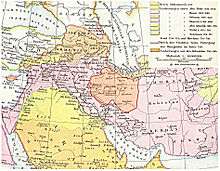Jibal

Jibāl (Arabic: جبال) was the name given by the Arabs to a region and province located in western Iran, under the Umayyad and Abbasid Caliphates.
Its name means "The Mountains", and is the plural of jabal, "mountain, hill", highlighting the region's mountainous nature.[1][2] Between the 12th and 14th centuries, the name Jibal was progressively abandoned, and it came to be mistakenly referred to as ʿIrāq ʿAjamī ("Persian Iraq") to distinguish it from "Arab Iraq" in Mesopotamia.[1][3][4] The region never had any precisely defined boundaries, but was held to be bounded by the Maranjab Desert in the east, by Fars and Khuzistan in the south, by Iraq in the south-west and west, by Adharbayjan in the north-west and by the Alborz Mountains in the north, making it roughly coterminous with the ancient country of Media.[1][3]
Under the Abbasid Caliphate, Jibal formed a separate province, with its capital usually at Rayy, until the Abbasids lost control in the early 10th century.[3] For most of the 9th century, however, the area was ruled by an autonomous local dynasty, the Dulafids.[3][5] In the late 10th and early 11th century, the larger portion of Jibal became one of the Buyid emirates, while the south passed to the Kakuyids.[3]
References
- 1 2 3 Lockhart 1991, p. 534.
- ↑ Le Strange 1905, p. 185.
- 1 2 3 4 5 Bosworth 1998, p. 538.
- ↑ Le Strange 1905, pp. 185–186.
- ↑ Donner 1995, pp. 476–477.
Sources
- Bosworth, C. E. (1998). "ʿERĀQ-E ʿAJAM(Ī)". Encyclopaedia Iranica, Vol. VIII, Fasc. 5. p. 538. Retrieved 22 September 2014.
- Donner, Fred M. (1995). "DOLAFIDS". Encyclopaedia Iranica, Vol. VII, Fasc. 5. pp. 476–477. Retrieved 22 September 2014.
- Le Strange, Guy (1905). The Lands of the Eastern Caliphate: Mesopotamia, Persia, and Central Asia, from the Moslem Conquest to the Time of Timur. New York: Barnes & Noble, Inc. OCLC 1044046.
- Lockhart, L. (1991). "D̲j̲ibāl". The Encyclopedia of Islam, New Edition, Volume II: C–G. Leiden and New York: BRILL. p. 534. ISBN 90-04-07026-5.